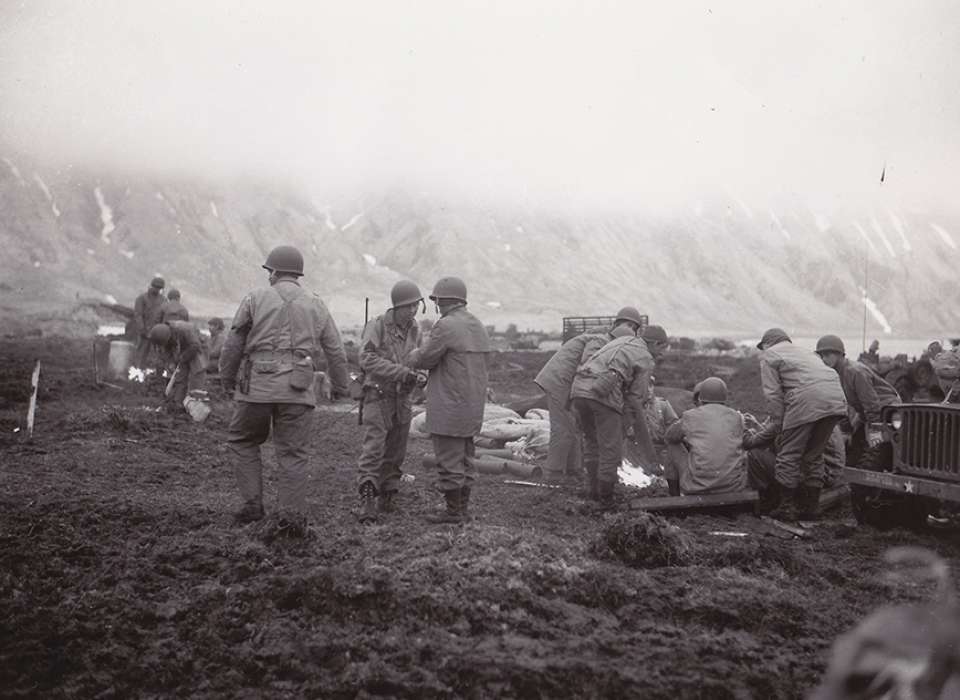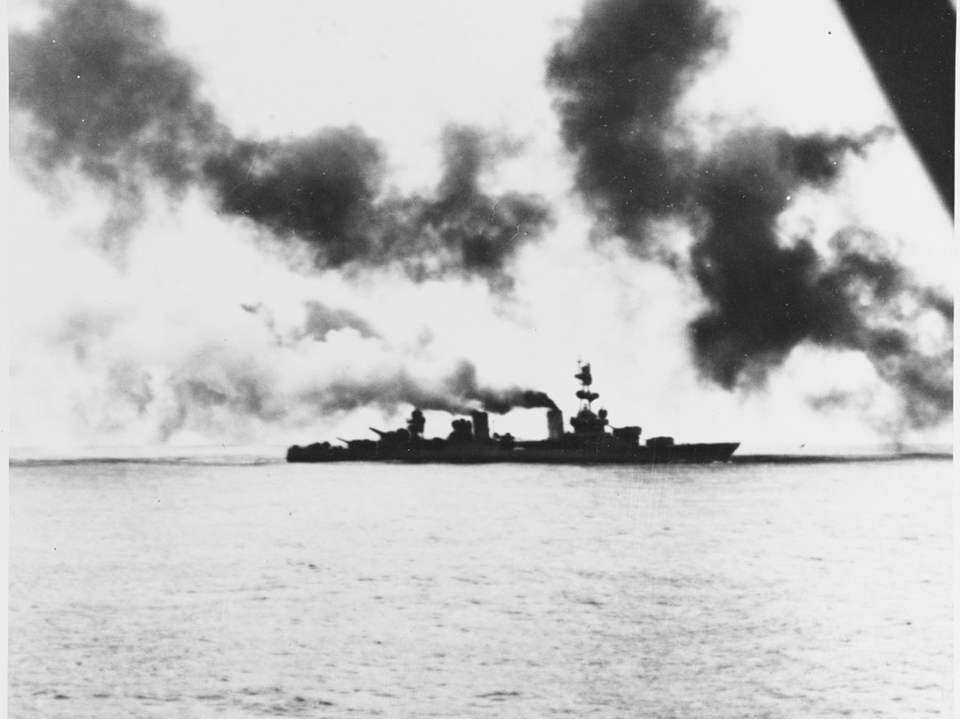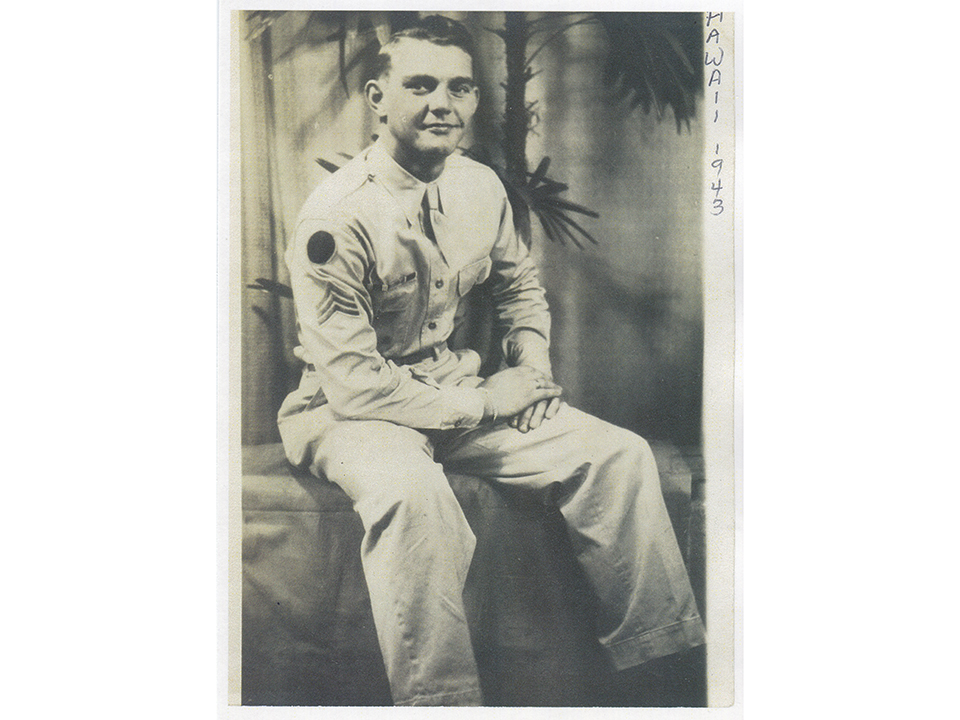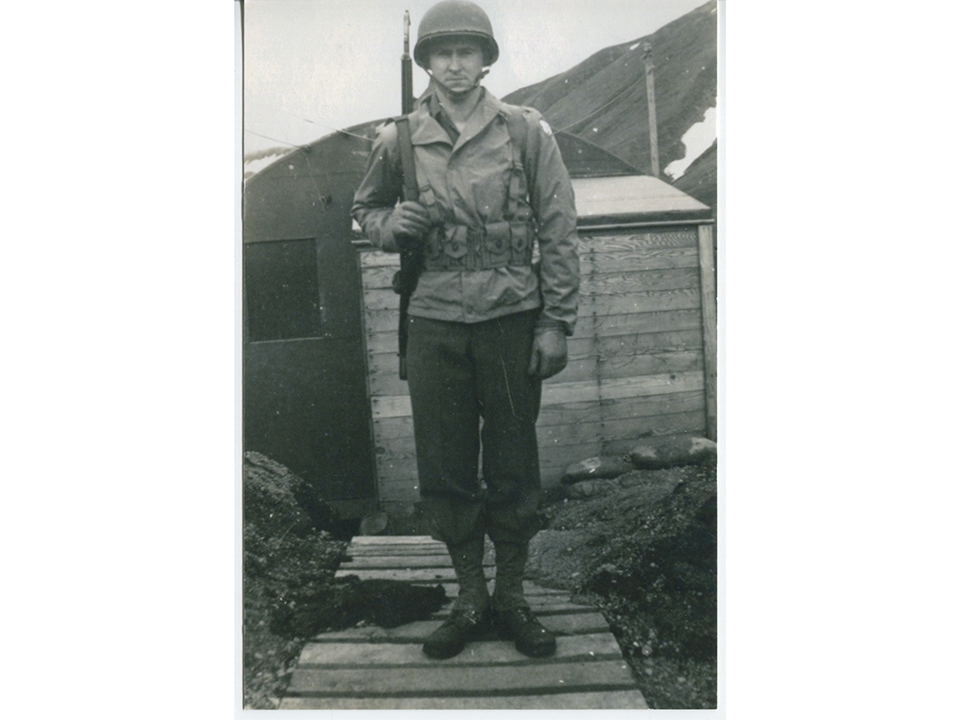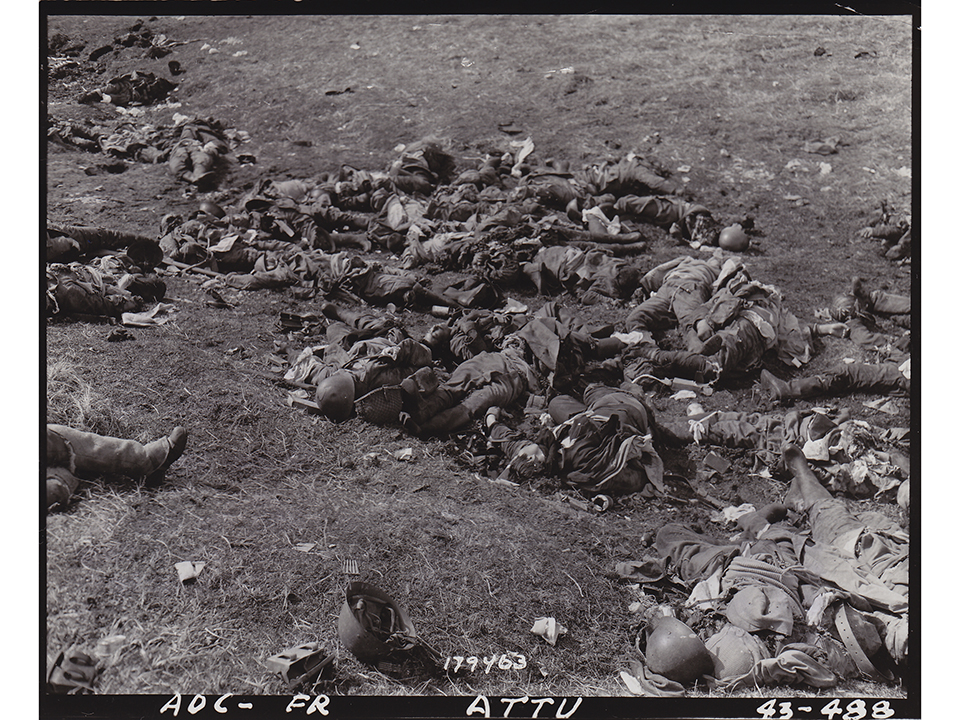After occupying the Western Aleutian Islands of Attu and Kiska in June 1942, the Japanese forces on those islands were supplied by convoys from bases in the Japanese Home Islands and on the island of Paramushiro. To stem the flow of supplies to the enemy garrisons the US Navy set up a blockade. On March 26, 1943, one of those supply convoys was intercepted by a task force under the command of Rear Admiral Charles “Soc” McMorris. The warships escorting the Japanese convoy outnumbered the American task force by two to one in heavy ships, but that did not stop McMorris from engaging them. At 8:42 a.m., the heavy cruiser USS Salt Lake City (CA-25) fired a salvo of 8” armor piercing shells at the Nachi, the flagship of the Japanese convoy. Almost simultaneously, the Nachi replied with a salvo of her own. The Battle of the Komandorski Islands had begun.
March 26, 1943 USS Salt Lake City (CA-25) in action during the battle, with an enemy salvo landing astern. Image courtesy of the National Archives and Records Administration.
The battle lasted nearly three and a half hours. During the melee, the Salt Lake City was hit several times by 8” shells. Sea water pouring in through holes in her hull polluted the ship’s fuel and extinguished her boilers, causing the ship to go dead in the water. With fuel oil spilling out of a ruptured bunker, Machinist’s Mate 2nd Class James F. “Fran” McCorriston, at his general quarters station in one of the ship’s engine rooms, thought:
“if the Salt Lake City took another hit she would have become the first cruiser on the moon.”
Destroyers quickly laid a smoke screen to shield the Salt Lake City, then turned on the Japanese ships which had continued to close the distance between them. The American destroyers launched a valiant, but ineffective, torpedo attack. The Japanese warships continued to close on the American task force which they now had on the ropes.
The American ships were in trouble. The Salt Lake City was dead in the water and only able to fire guns in one of her main battery turrets. McMorris’s other cruiser, the light cruiser USS Richmond (CL-9), was 30 years old and her 12 6”/53 caliber main battery guns were no match for Japanese Admiral Hosogaya’s two heavy and two light cruisers barreling down on the American task force.
Then, in a move that stunned McMorris and every American sailor with him, the Japanese warships broke contact shortly after noon and retreated from the battle area. Many theories abound as to why the Japanese broke contact, but whatever the reason, the March 26, 1943 Battle of the Komandorski Islands marked the last attempt by the Japanese to resupply Kiska and Attu by convoy for the remainder of the war. It was also the longest naval gun battle of the war and the last pure ship-to-ship battle in modern naval history.
By May 1943 the US Army Air Forces, along with elements of the Royal Canadian Air Force, had been bombing and strafing Japanese positions and facilities on Kiska and Attu on a somewhat regular basis. In addition to these aerial attacks, American naval vessels, ranging in size from submarines to battleships, had been bombarding the enemy held islands for months. Now, it was the Army’s turn.
On the morning of May 11, 1943, the US 7th Infantry Division landed on Attu and began driving inland from the invasion beaches. Over the next 19 days, the American troops ashore would fight for every inch of ground gained against a determined enemy, through some of the harshest combat conditions of the entire war. The 7th Infantry Division had been shipped to the Aleutians soon after completing desert training. In order to conceal their destination, which was assumed to be North Africa, no specialized cold weather gear was loaded aboard the transports. When the GIs went ashore on Attu they were wearing the same uniforms and carrying the same equipment they had trained with in the California desert. During the three weeks of fighting on Attu the temperature rarely went above 40° Fahrenheit.
Those combat and support troops who went ashore after the initial invasion were better equipped to handle the cold, but frontline infantrymen like Lieutenant Stanley Wolczyk—the commander of 1st Platoon, Company G, 32nd Infantry Regiment—were forced to strip the cold weather gear off of the dead. Even though taking gear from a dead soldier somewhat repulsed Wolczyk, he and his men were forced to do it anyway. Referring to the act, Wolczyk said, “if they happen to die, our fellows would steal their jackets, their parkas, and their boots. Can you imagine stealing? Not stealing but the poor soldier couldn't use it anymore, and we could have some benefit from these people bringing it in.”
Wolczyk had landed with the initial assault waves on Yellow Beach in Massacre Bay and fought his way across the island. A few days before the Battle of Attu came to an end, he was critically wounded when he was shot by a Japanese soldier. He was evacuated from the island and returned to the United States, where he spent the next 18 months recovering from his wound. He was separated from service in the fall of 1944, nearly a year before the war against Japan ended.
Another thing the American troops had to contend with was the tundra. Attu, like many of the islands in the Aleutians, is covered by a layer of muskeg tundra several inches thick, which covers a layer of dense, gooey mud. Movement across the tundra was nearly impossible except by foot. Wheeled and tracked vehicles were restricted to the creek beds that criss-crossed the island for the most part. The leather boots worn by those American soldiers who went ashore first on Attu were not at all suited for the terrain and resulted in an unforgivable amount of frostbite and frozen feet. Ultimately, there were more casualties caused by the cold than by the Japanese.
Sgt. William S. Jones in Hawaii after the Battle of Attu. Gift of William S. Jones, OH.2021.
Another soldier who landed on Attu on the morning of May 11, 1943 was William S. Jones of Company G, 17th Infantry Regiment. Jones landed at Blue Beach on the Southeast coast of Attu and moved with his company into Massacre Valley, so named for the massacre there of Unangan, the native Aleuts, by Russian fur traders in the late 1700s. In May 1943, Massacre Valley continued to live up to its name. American casualties were so high that within three days of going ashore Jones was promoted from PFC to sergeant and found himself leading a squad.
For more than two weeks, Jones and his men fought and slogged their way through Massacre Valley, over the Hogback, into Jarmin Pass then finally into the hills and mountains overlooking Chichagof Harbor. Jones and his fellow infantrymen had to fight for nearly every inch of frozen, bloody ground they took. The Japanese troops opposing them were highly skilled and very effectively used the terrain to their advantage. Often, the American troops came under fire from individual or small groups of Japanese soldiers who seemed to materialize out of nowhere then vanished just as quickly.
It was one of these phantoms that ended the fight, but not the terror, for Jones. Late on the afternoon of May 27, he was hit in the calf by a bullet fired by a Japanese soldier he never saw. This was the fourth wound Jones had sustained since arriving on Attu just over two weeks earlier. Two or three days after he landed on the island a rifle bullet grazed his arm, but he was so cold he didn’t even realize he had been hit until the next day. Then, on May 19, a piece of shrapnel from a Japanese grenade or mortar round hit Jones in the mouth, tearing a thumb sized hole in his jaw, knocking out some of his teeth, and exposing the roots of others. Being so near the front, there was not much that could be done for him. He just gritted his remaining teeth and toughed out the pain.
When Jones was hit for the fourth time on May 27, there was no one around to help him. He spent several hours limping and crawling toward a medical clearing station he knew was on one of the slopes of a nearby terrain feature known as Engineer Hill. He was eventually located by other American troops who picked him up and got him to the station the next day. Jones had survived two weeks of intense combat under some of the harshest conditions imaginable, but here in the relative safety of the medical clearing station, he would have his most frightening experience of the war. After the medics treated his wounds Jones was placed in a ward tent, the middle tent in a row of three, to await evacuation back to the beach at Massacre Bay. In that hospital tent early the following morning, Jones would find himself in the middle of the most ferocious assault of the Battle of Attu.
By this point in the battle, Colonel Yasuyo Yamasaki, the commander of the Japanese troops on Attu, knew that his forces had no hope of defeating the Americans. He also knew no resupply or reinforcements would be coming from Japan. His only option was to attack. Yamasaki concocted a plan that stood little chance of success, but he had to try. The idea was that he and his men would attempt to breach the American perimeter and capture a 105mm artillery battery located on top of Engineer Hill. They would then turn the guns on the Americans, in order to clear a path for themselves to the Massacre Bay landing beaches where the American supply dumps were located. The surviving Japanese troops would take what they could carry from the supply dumps then burn the rest and scatter into the hills. After all, if they left the Americans with no supplies, the Americans would not be able to continue the fight.
In the pre-dawn darkness of May 29, 1943, Yamasaki put his plan into action. He gathered his remaining troops who were still physically able to fight and prepared them for the final assault. Those who were not in any condition to take part in the final battle either committed suicide or were killed by someone else. In the Japanese garrison’s hospital, Doctor Paul Nobuo Tatsuguchi used morphine and hand grenades to kill hundreds of sick and wounded Japanese soldiers. Then, at 3:30 a.m., Yamasaki and his men moved out. The battle of Attu was about to come to a frightening, violent, vicious end.
The Japanese troops moved quietly through the fog and managed to get through the American front lines without being detected. Roughly half of the 1st Battalion, 32nd Infantry Regiment, which was positioned right in the middle of Chichagof Valley—the front lines for all intents and purposes—had received orders to march to a rear area where a field kitchen was set up and preparing breakfast for them. For many of the men heading to the rear that morning, it would be their first hot meal in nearly three weeks. As they headed to the rear, however, their absence allowed the bulk of the Japanese force to get through the American lines nearly unnoticed. The fog helped to conceal their advance as well. After penetrating the American lines, however, the Japanese forces became somewhat dispersed. Most of them continued moving toward the American artillery battery atop Engineer Hill, while a small group found itself at the site of one of the 7th Medical Battalion’s clearing companies, the same clearing station in which William S. Jones had been treated and was waiting to be evacuated. Those Japanese troops quickly engaged and eliminated the American medics, doctors and other company personnel. Few of the men in the clearing company were armed so there was not much of a fight. The Japanese then went about killing the wounded in the ward tents.
What Jones and the other wounded men in the medical clearing station must have endured that morning is unimaginable. According to Jones, the Japanese troops threw hand grenades into the two outside tents, one of which caught fire with wounded American soldiers still in it. They then entered one of the other tents and went cot to cot, bayoneting those wounded men who were still alive. Jones and the others who were in the middle tent survived, but only because one of the wounded officers had the foresight to drag the body of a man who had been hit and killed by a stray bullet or piece of shrapnel into the doorway of the tent. They were also protected by a lot of luck. Several Japanese soldiers had seen the body in the doorway and, possibly assuming the tent was a morgue, had gone on their way. One Japanese soldier, however, wanted to see what was inside. He was stepping over the body lying in the doorway when one of his comrades called him. He glanced around in the darkness inside the tent, but didn’t see anything and he left.
After killing most of the wounded in the medical clearing station, this group of Japanese soldiers continued on and rejoined the bulk of the Japanese force at the base of Engineer Hill. The Japanese began attacking up Engineer Hill at approximately 5:00 a.m. There, they were stopped cold by a hastily formed line of engineers, cooks, clerks, and anyone else capable of firing a rifle, including Brigadier General Archibald V. Arnold, Assistant Division Commander of the 7th Infantry Division who had his command post set up atop the hill.
Another of the men fighting desperately to stop the Japanese banzai attack was Joseph Sasser of the 50th Engineer Combat Regiment, who was sound asleep when the attack began. He was roused from his slumber and quickly took his place on the line. Sasser stated that throughout the battle for Engineer Hill, the fog and darkness made it difficult for him to see the enemy troops he was facing. Still, he continued firing his M1 rifle in the direction of the oncoming Japanese, but without knowing if he hit anyone.
The first assault on Engineer Hill was stopped in its tracks. The Japanese fell back a few hundred yards, regrouped and attacked up the hill again. This time, Colonel Yamasaki was hit by rifle fire and killed. When the remaining 500 or so Japanese soldiers realized that they had lost, they fell back to the base of Engineer Hill. There, the Japanese soldiers committed suicide almost to the man.
So, that was it—the Battle of Attu was over. As the sun came up on May 29, 1943, the Americans conducted some patrol operations, but encountered just a few enemy here and there. The cost to take the island had been brutally high on both sides. American casualties were 579 men killed, over 1,200 wounded and approximately twice that number suffering from weather related injuries—but that only reflects the losses suffered by the Army. The Army Air Forces and Navy suffered at Attu as well. In proportion to the number of troops involved, the total casualties suffered by the US Army on Attu was second only to those suffered by the Marines on Iwo Jima. Losses on the Japanese side were even higher. All but 28 of the 2,400 man Japanese garrison on Attu perished—a casualty rate of nearly 99 percent.
After Attu was retaken by the Americans it was obvious to the Japanese that they could not adequately resupply, much less hold Kiska, so the decision was made to abandon it. Prior to the Allied landings there in August 1943, the Japanese evacuated all of their troops from the island, leaving behind quantities of weapons, ammunition and other supplies. The invading American and Canadian troops found evidence of the enemy’s presence, but the Japanese themselves had gone. The war in the Aleutians was over. The Japanese threat in America’s backyard had been removed.
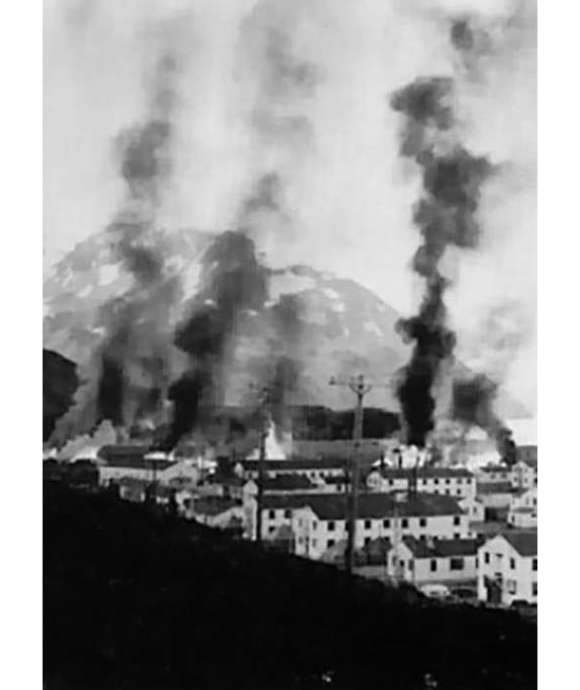
The Opening Round of the War in the Aleutians
In early June 1942, Japanese forces attacked the American military facilities at Dutch Harbor, Alaska, kicking off the 13 month Aleutian Islands Campaign.
Joey Balfour
Joey Balfour is the Assistant Director of Oral History at The National WWII Museum and oversees the collection, preservation, of curation of the interviews housed in the Museum’s Oral History Collection.
Cite this article:
MLA Citation:
APA Citation:
Chicago Style Citation:
